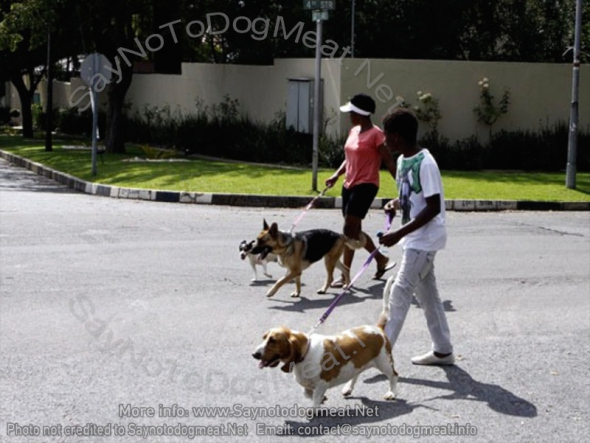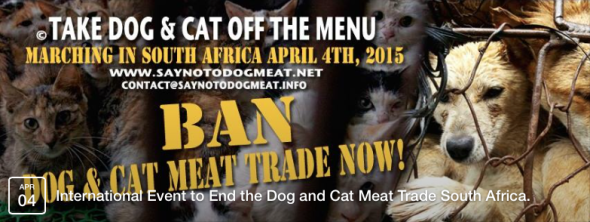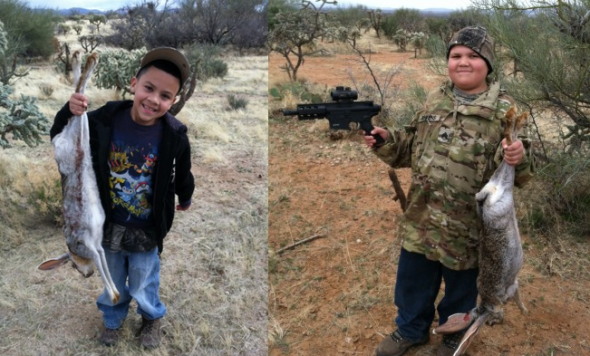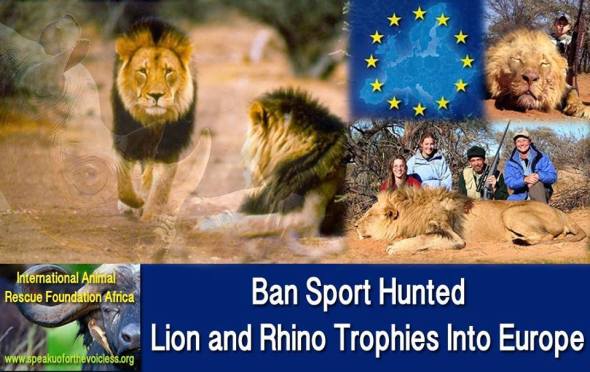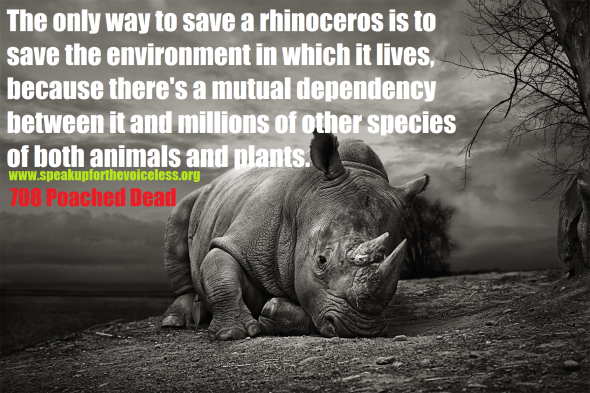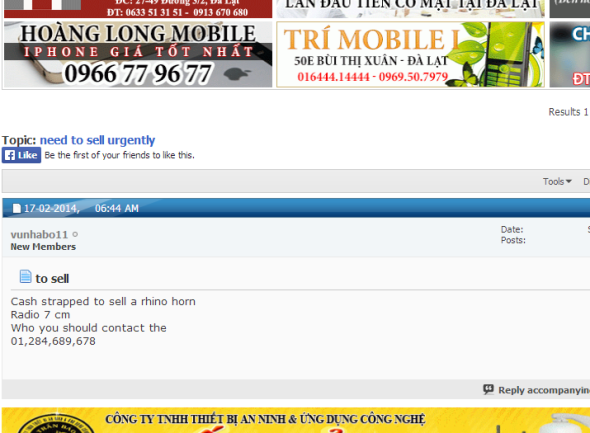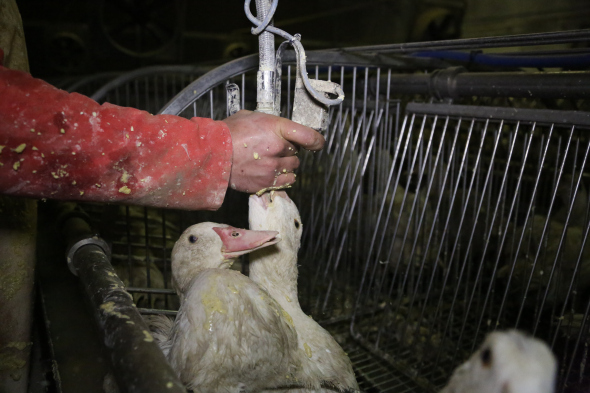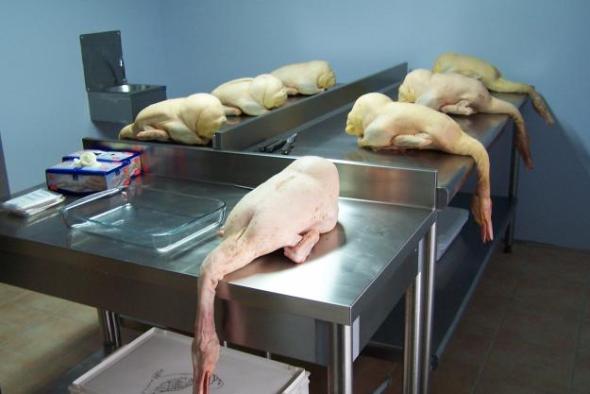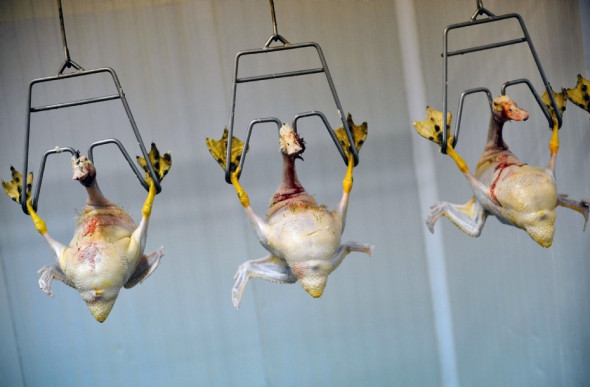South Africa: President Says Dogs Should Not Be Mans Best Friend
According to the South African president Jacob Zuma, owning a pet is part of ‘white culture’ and people should focus on family welfare instead. He says a dog should not be man’s best friend. The president’s statement, which was made a little over a year ago was met by anger from many pet lovers.
His presidential office tried to smooth things over by telling Star news he was encouraging “the previously oppressed African majority” to uphold its own culture.
“Will I become ‘more African’ if I kick my dog, President Zuma,” asked an angry pet owner.
One humorist wrote: “Well, that pretty much rules out that photo opportunity with Zuma, the Obamas and their pet dog, Bo, in the White House.”
During his speech to an appreciative crowd in his home province KwaZulu-Natal, the president said people who love dogs more than people have a “lack of humanity” and that some people are trying in vain to “emulate whiteness.”
“Even if you apply any kind of lotion and straighten your hair, you will never be white,” said the president.
Star news said he gave examples of people loving animals more than other human beings — letting a dog sit in the cab of a truck while a worker has to sit in the back in the rain, or rushing an animal to the veterinarian while ignoring sick relatives or workers.
Saynotodogmeat.Net is pleased to announce South Africa is participating in our Global March For Dogs and Cats In The Meat Trade!
We invite all South African pet lovers to join our march and bring your family and pets too, April 4th, 2015.
Africa hosts a lucrative dog and cat meat trade which has been kept in the shadows for too long. We are fighting to end the cruel pet meat trade in Africa and Asia. People from many nations will be marching with us, as one collective voice and we hope you will join us too. Please go ahead and mark your calendar. Join us and become the voice of the voiceless.
For information on our global march or how you can help us, please email us: CONTACT@SAYNOTODOGMEAT.INFO.
Thank you for reading,
Michele Brown.
GLOBAL MARCH
Saturday April 4th, 2015 Saynotodogmeat.Net is hosting a Global March for dogs and cats in the live meat trade. Please march with us, in your country. It will be an orderly and peaceful march but we need more ‘demonstration leaders.’ If you can help us, PLEASE EMAIL: CONTACT@SAYNOTODOGMEAT.INFO
Bring your family, children, pets and banners; we need as many people as possible, worldwide. Please mark your calendar and join our march. If you haven’t already done so, please click the box to let us know you are coming: https://www.facebook.com/events/294347744053559/
WE ARE NOW ACCEPTING DONATIONS
Saynotodogmeat.Net is now accepting donations: PLEASE MARK ALL DONATIONS “SAY NO TO DOG MEAT.NET” https://www.facebook.com/SayNoToDogMeat/app_117708921611213
No donation is too small and we are very appreciative of your help and support. Very soon we will be writing a full article outlining where donations will be used. You will receive an electronic receipt and we will too, which we will keep for historical data purposes. NO DONATION will be used to produce clothing with logos on, badges or banners. Donations are NOT for the directors. ALL MEMBERS FUND THEMSELVES.
PLEASE CONTINUE TO SIGN AND SHARE OUR SAYNOTODOGMEAT.NET PETITIONS; WHEN COMPLETED THEY’LL BE WILL BE HAND DELIVERED
PETITION FOR SOUTH KOREA
https://www.change.org/en-GB/petitions/president-geun-hye-park-take-dog-cat-meat-off-the-menu
PETITION FOR VIETNAM and THAILAND ANTI-SMUGGLING
https://www.causes.com/actions/1764795-a-petition-to-president-truong-tang-sang-moj-prime-minister-yingluck-shinawatra
PETITION FOR HEALTH MINISTER OF VIETNAM
https://www.causes.com/campaigns/71258-minister-of-public-health-thi-kim-tien
PETITION FOR NAGALAND
https://www.change.org/en-GB/petitions/additional-chief-secretary-take-dog-meat-of-nagaland-menu
PETITION TO BAN THE TRADE IN NIGERIA
https://www.change.org/en-GB/petitions/governor-of-lagos-hon-babatunde-fashola-ban-the-nigerian-dog-meat-trade-lagos
LETTER TO THE PRESIDENT OF THE PHILIPPINES
http://saynotodogmeat.net/2014/04/04/email-the-philippines-president-to-end-the-dog-meat-trade/
PLEASE SEND TO THE MUSLIM COUNCIL
http://saynotodogmeat.net/2014/01/17/open-email-to-the-muslim-council-of-great-britain/
PLEASE HELP THE PEOPLE OF TURKANA HERE
http://saynotodogmeat.net/2014/01/31/turkana-africa-emergency-aid-letter/
EMAIL THE GOVERNOR OF NIGERIA: New Address: info@nigeria.gov.ng
http://saynotodogmeat.net/2013/12/03/email-excellency-dr-honorable-alausa-excellency-honorable-babatunde-fashola/
JOIN THE WORLDWIDE GLOBAL EVENT HERE TODAY
PLEASE EMAIL US A.S.A.P FOR INFORMATION ON HOW YOU CAN HELP. SATURDAY 4TH APRIL 2015 – TIME TO MARCH FOR DOGS AND CATS IN THE MEAT TRADE.
JOIN HERE https://www.facebook.com/events/294347744053559/ SHARE EVERYWHERE WILDLY
SayNoToDogMeat.Net FACEBOOK and TWITTER
Email: contact@saynotodogmeat.info
#saynotodogmeat
ALL RIGHTS RESERVED
PLEASE CREDIT THE ORGANISATION WHEN SHARING
Child Abuse?
Meet Max Arredondo pictured below he’s aged from which he shot this Zebra with quite a heavy firearm within the Eastern Cape of Southern Africa. Aged just six its quite hard to actually take on board that there are parents out there teaching their children to kill animals. Unfortunately Max Arredondo is not the only child that is being taught to kill animals on the continent of Africa. Data reviewed by International Animal Rescue Foundation Africa has revealed more and more parents are now taking their children on safaris thus teaching them to kill.
This species of Zebra is not endangered, nor threatened.
Below is a comparison showing the legal ages to hunt and own firearms to that of the legal ages to watch films, play games
Speak up for the Voiceless.org has documented quite heavily on child hunters. Our partners International Animal Rescue Foundation Africa are now lobbying the Department of Environmental Affairs - Hon Edna Molewa head minister to introduce laws that will hopefully ban children from hunting. While its quite impossible to actually ban hunting in general, it is our duty of responsibility to now call for more tougher laws that “protect both children and animals”. Protecting children from adult violent activities and protecting animals from uneducated and inexperienced hunters that can inflict more pain and suffering to an animal. While Max may be an “educated” hunter it quite concerning to know that at such a young age his brain has been exposed to such violent activities.
In reality a mother or father teaching their child to kill an animal legally or illegally with a high powered weapon is no different to that of a parent placing their child in front of a (adult rated) television program that contains swearing, death, animal killing and more. Take a look at the following video below from YouTube like many hundreds online is classed as “age-restricted based on our Community Guidelines”. Its not just YouTube either that place these restrictions of which you require a Gmail account too log into.
YouTube state;
Age-restricted content
In some cases, real, dramatized or fake violence may not be suitable for all ages. “Similar to movie or television ratings”, our age-restrictions help viewers avoid watching content that they may not feel is acceptable for themselves or for their children.
YouTube goes on to state;
What we consider to be agree restricted
- Whether the video shows scenes containing physical attacks where the injury sustained is bloody or gory.
- Whether the video shows the graphic aftermath of a violent act.
- Whether the shots of violence or gore are the focal point of the video.
- Whether the violence contained in the video is realistic when posted in a dramatic context.
In South Africa, a temporary firearms and ammunition importation permit will only be issued at the port of entry if the applicant is twenty one (21) years of age or older. Does this law apply to native citizens too? Of course it does. The minimum age for gun ownership in South Africa is 21 years, with some exceptions that may include the fact that the applicant conducts a business, is gainfully employed, a dedicated hunter, a dedicated sports person or a private collector. Max pictured above is not anywhere near the minimum - he is six however doesn’t own this rifle. Laws state that you have to be 16 or older to hunt within South Africa, in some provinces the laws state that you have to be 14 years of age. The hunt above was most likely on a farm of which “no laws apply” to this activity. Had it been in the wild the chances are father and mother would be in a spot of bother.
In South Africa film are classified by the Film and Publication Board.[74] All broadcasters, cinemas and distributors of DVD/video and computer games must comply with the following:
- A: Suitable for all.
- PG: Parental Guidance
- 7–9PG: Not suitable for children under the age of 7. Children aged 7–9 years old may not be admitted unless accompanied by an adult.
- 10: Not suitable for children under the age of 10.
- 10–12PG: Not suitable for children under the age of 10. Children aged 10–12 years old may not be admitted unless accompanied by an adult.
- 13: Not suitable for children under the age of 13.
- 16: Not suitable for persons under the age of 16.
- 18: Not suitable for persons under the age of 18.
- X18: No One Under 18 Admitted; restricted to licensed adult premises.
- XX: Must not be distributed or exhibited in public.
Films that contain violence, death or “adult” content under South African law with regards to (PG) - 7–9PG: Not suitable for children under the age of 7. Children aged 7–9 years old may not be admitted unless accompanied by an adult.
As one can clearly see laws within South Africa are somewhat odd. Its “just reasonably” OK-ish to place a firearm within your child’s hands at the age of six and allow him or her to hunt an animal of which this is classified as “a violent and abusive act” but not reasonable to allow your child to view a “violent act[s] or abuse[s]” under the age of seven. Max in this case is 6. How does a violent video or game differ from that of a child taking a shot at a Zebra? It doesn’t of which this is in all due respects child abuse.
Exposing Children to Violence or Violent Acts
FACT - In 2011, nearly 60 percent of children (ages 17 and younger) were exposed to violence within the past year, either directly (as victims) or indirectly (as witnesses). Detailed documentation related mainly to domestic abuse, bullying, murder, animal abuse, rape, other. Regardless of what the type abuse children were exposed too, abuse is abuse no matter how much you try to sugar coat it, make it sound legal or necessary. Placing a gun in a the hands of a child at the age of six while the brain is still developing from 0-21 years of age is “exposing a vulnerable person” to abuse that can later on enact these same type of abuses out from which they see as “normal practice”.
Children are more likely to be exposed to violence and crime than adults are. An experience of violence can lead to lasting physical, mental, and emotional harm, whether the child is a direct victim or a witness. Children who are exposed to violence are more likely to suffer from attachment problems, regressive behavior, anxiety, and depression, and to have aggression and conduct problems. Other health-related problems, as well as academic and cognitive problems, delinquency, and involvement in the child welfare and juvenile justice systems, are also associated with experiences of violence. Even community violence that children do not directly witness has been shown to affect negatively children’s attentional abilities and cognitive performance.
One mechanism through which early, chronic exposure to violence affects children is by disrupting the developing brain. Specific brain structures (amygdala, hippocampus, prefrontal cortex) are adversely affected by stress. Executive functions (such as planning, memory, focusing attention, impulse control, and using new information to make decisions) can become impaired. Moreover, children who have had chronic exposure to real or perceived threats may become conditioned to react with fear and anxiety to a broad range of circumstances. Their diminished capacity to differentiate between genuine threats and objectively safe or neutral situations can impair their ability to learn and interact with others, and may lead to serious anxiety disorders. Unfortunately, while fear learning happens early in life, with emotional memories that are powerful and persistent, unlearning fears depends upon brain maturation that happens only later, and requires active work and evidence-based treatment.
Children exposed to violence are more likely than those not experiencing violence to become victims or perpetrators of further violence.
In conclusion exposing children to violence does impair their own understanding of violence in itself. If a child has been taught a violent act and is educated on inflicting violence then what’s to say that child will not then inflict that violence onto another person or animal. We see this form of child abuse as one of the worst simply because the child has been in one way or the other “educated”. They know how to use a rifle, their fear of death and wrongdoings is decreased, empathy and care although still present is somewhat pushed aside. A child not exposed to violence but love will show more compassion and emotion at seeing a dead, injured of suffering being than that of a child exposed and educated of violence acts. The video below depicts how Green Mile Safari had their hunting licences revoked after many breaches of hunting activities. Children hunting, running over dead animals in cars, hunting animals from a moving vehicle and more. Believe it or not there are many more cases such as these on South African farms from which many tourists and their families visit.
Thank you for reading. To stay up to date on African wildlife affairs please visit our Facebook page here.
You can also sign petitions below.
https://www.causes.com/campaigns/34435-stop-any-kind-of-safari-hunting-in-africa
http://www.change.org/p/stop-canned-hunting-in-south-africa
https://www.change.org/p/hon-gianni-pittella-ban-lion-and-rhino-trophies-into-the-european-union
Restriction of Lion and Rhinoceros trophy imports into the the European Union.
OPEN LETTER & SENT COMMUNICATION
President José Manuel Barroso
European Commission
Berlaymont, Rue de la Loi, 200
1049 Bruxelles
Date: 17th October 2014
Re: European Legislation on Restriction of Lion and Rhinoceros trophy imports into the the European Union.
Brief summary;
We “International Animal Rescue Foundation” call for European Legislation to restrict the importation of sport hunted Lion and Rhino trophies (only) from “any country” into all European Countries within the European Union. We the named herein only support imports of Lion and Rhino parts or carcasses for veterinary science and museum artifacts for educative purposes only.
Dear President José Manuel Barroso;
Your Honorable José Manuel Barroso We International Animal Rescue Foundation Africa ask for your support to implement law[s] to restrict the import/export of Lion and Rhino sport hunted trophies into the European Union from (any country or continent). As set out under the European Union Legislation / Environmentalism and Preservation procedure stated hereto; http://eur-lex.europa.eu/legal-content/EN/TXT/?qid=1413671152558&uri=URISERV:l11023 it is the European Union and Commissions responsibility to protect the biodiversity and natural habitats of both Fauna and Flora. As we see it (now) the European Union/Commission and Parliament is failing within its duties under Protocol one of the Council Regulation (EC) No 338/97 of 9 December 1996 on the protection of species of wild fauna and flora by regulating trade either live or dead of Lion and Rhino trophies and/or parts.
We International Animal Rescue Foundation Africa call on the European Commission to now regulate trade of both sport “hunted” Lions and Rhinos under the Act of Council Regulation (EC) No 338/97 of 9 December 1996 on the protection of species of wild fauna and flora by regulating trade for the reasons as set out herein for your information.
Restrictions on sport hunted Lions and parts under Council Regulation (EC) No 338/97 of 9 December 1996 on the protection of species of wild fauna and flora by regulating/restricting trade;
- Since the early 1980’s we have lost countless individual Lions and Rhinos to sport hunters and poachers within Africa. While sport hunting may not be seen as a overall major threat to both species of Lion and Rhino it is having a detrimental effect on the now shrinking populations of Lions in Africa. And with regards to “poaching” of Rhinos something now has to give. The Rhino cannot any longer compete with the vast number of poaching incidents occurring daily of which has placed the Rhino now at tipping point. All in all your excellency should the candle continue to burn at both ends we will lose both ionic species of mammalian in under two decades. Poaching is raging out of control within Africa threatening many species alike. With South Africa being the largest country hit by poachers and visited by thousands of European and American tourist hunters a year, time must now come that we as a European Union must take evasive action to slow down and/or halt (extinction). The reasons are set out below for your information.
- A century ago there were some 200,000 Lions roaming all over the African continent. Now there are no fewer than a mere 30,000 if that with the lowest estimated figure pointing to a possible 15,000. Within the Lions existing ranges there are no more than 1,000 Lions within each of its African habituated countries of which there are more Lions within canned hunting farms and ranches than in some wild populated areas. Those Lions within canned hunting farms and ranches pose a disease and genetic risk to other species of fauna and wild Lion populations that live around these facilities.
- Over the last ten years a staggering two thirds of all Lions hunted for sport were imported from Africa into the United States of America Between 2000 and 2008, some 4,250 wild lions were exported as trophies most of which into the European Union although America was the largest importer and still is to date.
- African Lions have vanished from a whopping 80% of their range of which hunting, habitat fragmentation, human species conflict and unsustainable agriculture are primary causes for Lion depletion.
- Lions have become extinct in 26 countries. Only seven countries – Botswana, Ethiopia, Kenya, South Africa, Tanzania, Zambia and Zimbabwe – are believed to contain more than 1,000 lions each. Panthera leo is bordering endangerment. Should restrictions not be implemented and or bans put in place then it is a sad fact of life we will lose a further 1/4 of all mature individuals thus seeing more Lions pushed from extant into “regional” extinction.
- Although the single biggest threat by far to the animals survival is humans, though not necessarily western hunters. It is just the very, very widespread killing of Lions, mostly in a conflict situation, by anyone who is trying to farm livestock in Africa and finds it very difficult to co-exist with Lions. Hunting of Lions though is still playing a great role in reducing further species of which is seeing many Lions wild and captured depleted. Furthermore the black market trade in Lion bone wine threatens our Lion species greatly. International Animal Rescue Foundation Africa has already this year seen further evidence of European’s involved within the black market trade of Lion bones generating hundreds of thousands “in all”.. While this evidence is within the public domain and has been for some years why are we still not taking the relevant steps to secure the species future?
- Between 1999 and 2008, 64% of the 5,663 Lions that were killed in the African wild for sport ended up being shipped to America, it must also be noted numbers had risen sharply in those 10 years, with more than twice as many Lions taken as trophies by US hunters in 2008 than in 1999. Should US hunters continue their rampage followed up with EU hunters least forgetting habitat destruction then its quite likely we’ll begin to see more loclised (regional extinctions) within the next five years. In addition to personal trophies, Americans are also the world’s biggest buyers of Lion carcasses and body parts, including claws, skulls, bones and penises, Asians the second largest and Europeans the third largest buyer. In the same years, the US imported 63% of the 2,715 Lion specimens put up for sale. While the United States, Asia and Europe hunters buy and sell the demand for Lion parts continues thus seeing the species threatened furthermore.
- From 1996 – 2008 species populations of Panthera leo has not increased but decreased furthermore seeing few localised extinctions. The African Lion is still listed as vulnerable on the International Union for the Conservation of Nature’s Red List of Threatened Species. Listed as Endangered is the next step - then we will most certainly see the Lion species in danger furthermore.
- Demand from the Far East is also driving profits for Lions breeders. In 2001, two Lions were exported as “trophies” to China, Laos and Vietnam; in 2011, 70 Lion trophies were exported to those nations. While the trade in Tiger parts is now illegal, demand for Lion parts for traditional Asian medicine is soaring. In 2009, five Lion skeletons were exported from South Africa to Laos; in 2011, it was 496. The legal export of Lion bones and whole carcasses has also soared. While Tiger populations decrease so will Lions too.
- Lastly Eastern European countries such as Russia not aligned with the Cites convention nor the “European Union” are actively selling Lion skins into the market to produce rugs, upholstery, and furniture. This is a threat in its own and with all factors above combined with the trade in Eastern Europe we must now protect our Lion populations more than ever.
Restrictions on sport hunted Rhinoceros and parts under Council Regulation (EC) No 338/97 of 9 December 1996 on the protection of species of wild fauna and flora by regulating/restricting trade;
- In the early 1950s, when Mao Zedong promoted so-called traditional Chinese medicine (TCM) as a tool for unifying the country he had recently come to lead. Even though Chairman Mao himself did not believe in TCM, he called for its use over Western medicine. Among the many “cures” touted by China’s “New Medicine” was powdered Rhino horn, which was said to cure everything from fevers to cancer. Since Mao made this public Rhinos have been decimated at staggering proportions mostly by poachers. However now as the demand the Rhino horn has increased rapidly within Asia of which the horn can fetch on the market between $50,000 and $70,000kg hunters have been caught in many stings peddling Rhino horns from their “legally” obtained trophies to supply the (TCM) market. Since the year 2000 we have lost over 3,000 Rhinos just in South Africa alone.
- Between 1960 and 1995 an astonishing 98 percent of black Rhinos were killed by poachers, either to feed the new and voracious demand for TCM or, to a lesser extent, for horns to be used as ceremonial knife handles in the Middle East. From 2000 onwards both White and Black Rhino populations are now being hit hard by poachers, every day we lose a further 3-4 Rhinos in South Africa alone custodian to the worlds largest remaining Rhino crashes. Evidence. All rhinos suffered; the western black Rhino, already weakened by decades of overhunting, was the hardest hit. The white Rhino is now at “tipping point”.
- Back in 2012 the Department of Environmental Affairs (South Africa) banned Vietnamese hunting permits due to the popularity of pseudo hunting and the then past arrests of the Gronwald poaching gang and Chumlong Lemtongthai whom hired pseudo (hunters) from Thailand and possibly other fake hunters from Vietnam. Although banned - Vietnamese hunters this hasn’t stopped foreign citizens from joining in the hunting/poaching trend. It was stated by Hon Edna Molewa and Cites that Eastern European hunting applications had shot up from 2012 by some 1000% of which its now known that Polish, Russian and Czech Republic hunters are mostly pseudo hunters cashing in on the Rhino horn demand thus supplying the Asian market in Vietnam, Laos and China with Rhino horn. Whilst this is clearly evident and “legitimate” hunting practices still ongoing this is placing more pressure on the Rhino species decreasing their populations even more of which this “fake and legitimate hunting” plus poaching has led to the Rhino populations decreasing furthermore.
- Trophy hunting does not rake in revenue - A study on the economic benefit behind Lion hunting for example in Africa concluded, “The suggestion that trophy hunting plays a significant role in African economic development is misguided…Revenues constitute only a fraction of a percent of GDP and almost none of that ever reaches rural communities.” Dr. Naomi Rose agrees as stated on the HSUS blog, “Regarding the statement that trophy hunters do a lot for conservation, it’s true that some portion of some hunters’ fees goes to conservation in some countries, but it’s rarely the major source of conservation funding. Usually middlemen—commercial outfitters—take the lion’s share of sport hunting proceeds and local communities and conservation and management agencies get the dregs.” And its quite evident that trophy hunting is not generating revenue - if it was then why is this “alleged $200 million” not seen poaching tackled. It would be quite fare to say that $200 million x 4 years = $800 million is quite enough to sustain species welfare. Yet it hasn’t which is why we call for an immediate ban of LION and RHINO trophies into Europe.
- White Rhino is currently listed on the International Union for the Conservation of Nature’s Red List as (near threatened) Whilst we are aware that evidence has shown an “increase” of White Rhino populations poaching from either African “poachers” legal hunters and others caught (illegally poaching) has since pushed the species of White and Black Rhino to tipping point. Both Rhino species are normally gestate no longer than 15-16 months. One Rhino cow regardless of the species produces a new born every two to three years. However we are losing species of both Black and White Rhino at 3-4 every day. International Union for the Conservation of Nature has placed the number of White Rhinoceros populations at 20,160 (2010). Since 1990 and including the recent poaching figures for (October 2014) we have lost a total of 3,803 Rhinoceros. Most of these deaths have occurred in South Africa that holds a total of 93.2% of the worlds largest Rhino populations. 3,803 is not including “collateral damage” such as unborn fetus nor natural deaths. If we took unborn fetes and natural deaths into account with that of the 1990-2014 poaching figures its quite likely that the current population trend of White and Black Rhinos is nowhere near the 2010 figures of 20,160. As of 2012 International Animal Rescue Foundation Africa communicated to Hon Edna Molewa. In writing Molewa basically quoted from the IUCN the population of Rhino has increased “ten fold” mostly helped by hunters. Yet there is no evidence of such increases by even a “five fold” and if such hunting practices had increased the White and Black Rhino population then why is the Rhino populations within Africa now “threatened and still endangered” of which are standing at “tipping point”? The answer is quite simple. Our “wild Rhino” populations are decreasing rapidly. What Hon Edna Molewa most likely meant was that Rhino populations had increased ten fold on “hunting reserves” while the remainder of the wild populations the government nor Non-Profits know little about. No official census of the wild populations have been seen since the early millennium either. This gives us reason to now ask that all Rhino trophies and parts acquired via trophy hunting are banned from export/import into Europe unless for scientific and/or museum purposes. Why did Molewe not answer International Animal Rescue Foundation’s questions in full? Rather than simply copy and paste a number from the IUCN website? We believe this is because the South African government know little about their own populations of Rhino and what the real figure of wild populations of both black and white stand at. Moving back to the Census - A group of Rhino Activists did lobby the South African government (early 2012) asking for census within their (9 point plan) to be conducted supported by over 29,000 people.
- Rhinos still under threat no matter what the South African Government try to do to stem the poaching crisis - 2012 Vietnamese hunting permits were banned due to pseudo hunting. Department of Environmental Affairs believed this would someway “reduce the poaching crisis”. October 2014 though saw yet another Rhino poaching kingpin and accomplices being vets, pilots, even “HAWKS” police, arrested along with the leader himself Hugo Ras a South African hunter and attorney. Ras was known the police with regards to “poaching crimes”. The group is alleged to have contributed to the brutal slaughter and mutilation of 24 Rhinos in state and privately owned game reserves, resulting in 48 horns poached. Only two of the 24 Rhinos that had been attacked, survived, but they were de-horned after they had been darted. Twenty two of the Rhinos were darted with the veterinary drug M99, the other two were shot. An additional 36 horns were either stolen or obtained through other illegal means. The killings took place between 2008 and 2012, during which period the syndicate illegally obtained 84 Rhino horns and killed 22 Rhinos valued at nearly R22 million. International Animal Rescue Foundation Africa and International Animal Rescue Foundation Europe call for an immediate ban of all Rhino parts and trophies into Europe because there is more than likely more Rhino poaching syndicates operating of which Europe is being used as a transit route to peddle legally Rhino “trophies” through onto Asia. By cutting one of the main transit routes out we help to disrupt trade and demand furthermore.
- The rate of Rhino deaths has surpassed the rate of births. Rhino poaching has accelerated to a dangerous level. With deaths outweighing births, it puts their species just a few short years away from extinction. 1990 = 14 deaths, 1994 = 27 deaths, 2002 = 25 deaths, 2006 = 36 deaths, 2008 = 83 deaths, 2009 = 122 deaths, 2010 = 333 deaths, 2011 = 448 deaths, 2012 = 668 deaths, 2013 = 1004 deaths and to date October 2014 we stand almost at 900 deaths. While the majority of these deaths have been caused by African poachers killing Rhino to supply the Asian black market hunters, game wardens, farmers, veterinary officers and more are also contributing to deaths that we are still fully unaware of. While SAPS and HAWKS are flushing out corrupt hunters, wardens and vets poaching and corrupt hunting continues. What seems legitimate trophies being exported out off Africa in Europe could well be more sinister. Hence the reasons we call for a trophy hunting ban of Rhino into Europe from Africa based on the level of illegal poaching and that of pseudo poaching that has already been shown to be supplying the black market within Asia.
Since publishing our main petition aimed at Hon Gianni Pittella EPP, Hon Manfred Weber S&D, Hon Martin Schulz President of the European Parliament, Hon Herman Van Rompuy President of the European Council, Hon Jean Lambert MEP and Hon Keith Taylor MEP including yourself your Excellency we have amassed a total count nearing nine hundred signatures that call for a restriction of sport hunted Rhinos and Lions into all European member countries. Australia has already banned the importation/exportation of sport hunted Rhinoceros with a further ban expected of sport hunted Lions.
International Animal Rescue Foundation Africa lobbied with many other Non-Profits the United States too as of last year that has since prompted Director Daniel Ashe United States Fish and Wildlife Service to now look into banning/restricting sport hunted Lion trophies into the USA. Australia and the United States are taking leading steps here and setting positive and professional examples. However as yet Europe is still dragging its heals. While we continue to drag our heals both Lions and Rhinoceros continue to edge closer and closer to extinction. The time for the healing of the wounds has come your excellency.
Sincerely yours
Board of Directors
Josa C. Depre
Jon E. Williamson
Helen S. Farthing
Rosalyn Simon
J. C. Dimetri
Muhammad A. Muller
Sonya T. Franklin
Johan N. Strauss
info@international-animalrescue-foundation.org.uk
Please sign the petition here
Rhino Poaching - Tipping Point.
Rhinoceros poaching began to kick off at the very start of the millennium, back in 2002 we lost a total of around twenty five Rhinoceros. Never did we fathom Rhino poaching would be the ultimate new trend for Traditional Chinese Medicine or used as a status symbol to show wealth and prosperity.
Poaching statistics fluctuated between the years of 2003-2007 which saw a total of eighty two Rhinoceros, gunned down or poisoned with entorphine, faces hacked off and left for dead. The fluctuation between 2003-2007 we believe is due to new trends in the way Rhino horn is processed and used, least forgetting between this year there was much civil tension and wars ongoing of which the illegal wildlife trade funds astronomically.
International Animal Rescue Foundation Africa has already provided evidence to Interpol and Department of Environmental Affairs of Rhino and ivory parts workshops thriving in northern Africa where civil wars have been the spot light for media tension. Trade is not necessarily an issue here in Egypt, Algeria, Mali (north) and Tunisia but more a trafficking/pick up route. Money is parted that is then used to fuel terrorism and purchase firearms. This is an Act of Terror that all governments around the world affected by terrorism must now stand up too.
From 2007-2008 a colossal upsurge of Rhino poaching was seen with the Kruger National Park (KNP) baring yet again the brunt of poaching attacks that has since prompted SANParks and Edna Molewa Environmental Minster head of the Department of Environmental Affairs to order the evacuation of some five hundred Rhinoceros from the Kruger National Park situated next to Kabuk. Kabuk is known as the village that thrives on Rhino horn and is one of many small villages within the Mozambique Transfrontier range. No borders provides easy access for poachers to simply cross into the parks taking out many Rhino.
2008-2010 saw a staggering increase in Rhino horn poaching. From 2008-2010 South Africa lost (not including Rhinos poached over the border) a whopping 500+ Rhinoceros. One would have thought that with such a high security presence, increase in South African National Defense Force and intelligence teams working locally and internationally that poachers would have given up. Unfortunately this is not the case. Millions upon millions of dollars have been donated to various South African organisations and the South African Government yet the poaching continues. International Animal Rescue Foundation’s Chief Environmental Officer Dr Josa Depre quoted in a brief interview yesterday;
“Rhino poaching has reached unprecedented levels, with so much funding being pushed into South Africa to try and stem the flow of poaching one would have believed some improvement would have been seen”.. “The transfrontier fence has still yet to be erected, until this fence is erected poachers from Mozambique, Zimbabwe and north African poachers will continue to walk freely into South Africa slaughtering our mega-fauna”..
“Trans-locating some five hundred Rhino is a positive step in preserving some Kruger Rhino however should not be seen as a simple fix or solution. “All one is doing is moving danger out of Kruger elsewhere that could potentially see people’s lives placed in harms way”..
“Poachers will not stop just because a mere five hundred Rhinoceros have been moved, by moving them one is merely inviting poachers to travel further inland”.. “We have noticed within the past few months that heavily armed poachers are operating and living within Massingir that were not present over several months ago”.. It’s quite likely that by moving these Rhino the opportunistic native Mozambican and Zimbabwean will turn to these heavily armed and well trained military style poachers that could or may place human lives in danger”.. We are all aware that rangers and Anti Poaching Units have been attacked by the modest poachers, what’s to say north African poachers that are special forces trained will kill”… “
“We are now at the tipping point for both Rhino and Elephant, Rhino and Elephant populations have been heavily depleted over the border of Southern Africa so it’s quite evident that we will see in the next five months heavily armed, well trained north African poachers hitting the Kruger hard”.
Poaching is only the tip of a very large stinking iceberg though. Demand within Asia is still continuing whether it be for a pseudo medicine or used as a status symbol to show wealth. Online sales within Hanoi and Saigon are still continuing despite a complete trade ban. See picture below. International Animal Rescue Foundation’s (OTH) team Operation Trojan Horse monitors trade online of all animal parts banned under the Cites agreement. The trader below known as Vun-habo (login name) has been peddling Rhino horn parts since 2012. One only has to search Vietnamese classified advertisements and you’ll locate hundreds if not thousands of antique sellers and non-antique traders specializing in many medicines from facial creams, head ache cures down to rheumatic fever.
From 2011 to 2012 we lost just under one thousand Rhinoceros. Figures for 2011 end stood at 448 with 232 arrests. The following year 2012 end we lost a further 668 Rhinoceros which saw a combined arrest rate of some 267 poachers apprehended. For August 2014 poachers have already exceeded both statistical records from 2010-2012 of which we are now looking at staggering 708 Rhinoceros killed. By the end of the year International Animal Rescue Foundation Africa using model data puts the final statistics at a nauseating 1400 Rhinoceros poached.
Female Rhino cows reach sexual maturity at around 6-7 years old, males at between 10-12 years old. White Rhino have a gestation period of approximately 16 months. Females usually give birth for the first time at the age of 6.5-7 years. The interval between calving is 3-4 years. Pregnant females will leave their crash shortly before the parturition and stay apart for several days afterwards. Calves stand up within one hour, immediately attempting to suckle. Mother and calf become inseparable; the calf usually moves in front of its mother and immediately responds to the mother’s behavior. The calf begins grazing at two months, weaning occurs at around one year of age. The calf stays with mother for around three years.
Female cows cannot produce enough Rhino to keep up with the onslaught of poaching, we are finally at the tipping point which would probably give some inclination as to why Hon Edna Molewa and SANParks have decided to trans-locate some 500+ Rhinoceros, this movement though that has angered Animal Rights Activists has since been delayed. When going to press it was stated that Rhino to be moved where going to hunting lodges however this is not actually factual and no data has been released on where these Rhino will be re-located too. What we can state is and this is based on the very words from the Department of Environmental Affairs that it is possible these Rhino “may” be moved to areas where “sustainable utilization” will be practiced. I.e hunting. This brings us to our next concern. Many African Rhino farmers have stated publicly they hold to many Rhino. So if this is the case then why are these Rhino not re-located to provide monetary funding for sustainable utilization? Or is it the case that to many Rhino have been dehorned and hunters will only wish to hunt a Rhinoceros that hasn’t been disfigured?
Since 2012 reports have emerged that fake Rhino horns have been flooding the market within China and Vietnam. This has led to some concerns that it could well be increasing the poaching more. Please view pictures below.
Counterfeit Rhino horn trade is big business within Africa and Asia of which poses a significant threat to any proposed legal Rhinoceros horn trade, regardless of what the pro trade lobby has suggested within online forums and meetings with governmental environmental agencies.
Sophisticated syndicated and highly organised gangs are now making very high quality fake horns, allowing unscrupulous hunters to sell the real horns at a huge mark-up to black market dealers for traditional medicine and status symbols. The fake horns are made with top quality resins and look so authentic that they are almost impossible to distinguish from the real thing, a report presented July 2012 to members of the Convention on International Trade in Endangered Species (Cites) says. The report, presented to the convention’s standing committee in Geneva, says Cites officials have been alerted to the increasing involvement of “professional hunters in the illegal Rhino horn trade”. Yet hunters deny having any involvement within the trade whatsoever.
Cites did not specify in which country the fake horns were being made and sold, but details in the report point to the possible involvement of either American or European hunters in the fake horn scam. In 2012, wildlife investigators in the US arrested several American and Vietnamese nationals in a major bust in several cities across the US following the seizure of numerous Rhino horns, some of which were suspected to have originated from legal Rhino hunts in SA and other parts of the continent. Since 2012 there have been countless people apprehend involved in the peddling of counterfeit Rhino horn. The possibility that this “may” be increasing poaching within Africa is all to real.
Concluding;
Rhino poaching has reached record levels in South Africa, having escalated for five years in a row. On current trends, deaths have now pushed the Rhino to tipping point and unless something majorly drastic is not seen we will begin to see localized extinctions occurring within South Africa.
South Africa WAS home to 80 per cent of Africa’s Rhinos, but 1004 animals were killed there last year, compared with 668 in 2012, according to the South African Department of Environmental Affairs. No more than 36 were killed each year between 1990 and 2007, but poaching has increased exponentially since 2008. Other countries with Rhinos have seen similar increases.
The poaching escalation has sadly brought South Africa’s white Rhino population to a tipping point where deaths are now outnumbering births. It is no longer a fact of if but more when will we see extinctions occur. Cites signatories must now act and enforce sanctions on user nations, demand the transfrontier fence is erected, implement a Rhino hunting moratorium as evidence has shown hunters and the very people paid to preserve our Rhino have also been involved in killing them too.
The trade has mushroomed despite the introduction of tougher anti-poaching measures in South Africa, including more rangers and drone aircraft.
Supply and demand
Conservationists blame soaring demand in China and especially Vietnam, where Rhino horn has become a highly prized status symbol and valued gift, as revealed in a recent TRAFFIC report. South Africa’s tough stance is also being undermined by lax enforcement in neighboring Mozambique, which serves as a conduit for illegal Rhino material to the Far East. In Mozambique, people who steal chickens receive worse penalties than poachers caught with illegal Rhino horn, according to Mike Knight of the African Rhino Specialist Group of the International Union for Conservation of Nature in Port Elizabeth, South Africa.
South Africa and Mozambique must decisively up their game if they hope to stop this blatant robbery of southern Africa’s natural heritage. As well as tougher enforcement, reducing demand is crucial. We must put pressure on the countries that are creating demand, especially Vietnam and China. This year $350,000 was raised for Rhino conservation by auctioning off the right to kill a specific Rhino. It was alleged that if conservation groups hadn’t complained about the auction, it would have raised $1 million. No matter how many Rhino are being killed legally its not going to save them. Many farmers are now under the illusion that by 2016 the next Cites conference will see trade Rhino horn trade legalized. South Africa doesn’t stand a chance so as long as the killing continues coupled with demand and trade in Asia.
We are losing our Rhinoceros. The death toll to date stands at a staggering 700+.
Thank you for reading
Dr Josa Depre.
info@international-animalrescue-foundation.org.uk
Please view the video below and share this article. The video depicts children that are creating awareness of the current Rhino poaching trend. The more children we educate the possibility that future poaching crazes will decrease is quite possible. Education starts here and can have quite an impact.
Notice a typo? Please contact us above and we’ll correct it as soon as possible.
South African Foie Gras - Cruelty Certified
The trade in foie gras has caused quite a controversy over the past decade mostly within Europe and America. Animal rights activists and outspoken chefs have denounced the sadistic farming practice and horrific slaughter of ducks and geese force feed a cocktail of corn with a gavage. Gavage is the term commonly known as “feeding tube” that is rammed down the duck and goose neck into the animal’s oesophagus; if an auger is used, the feeding takes about 45 to 60 seconds. Modern systems usually use a tube fed by a pneumatic pump fed via a slit cut in the oesophagus; with such a system the operation time per duck takes about 2 to 3 seconds.
ENM prints on a wide range of animal and environmental issues locally and worldwide however have yet to document on the cruel foie gras trade within Africa. Many Africans seem completely oblivious that the food they are consuming has been placed through a hellish cycle of abuse and narcissistic torture.
The French (who produce 78% of the world’s foie gras) have taken recent bans very personal with a politician from foie gras producing Gascony calling on all French restaurants to ban California wines in solidarity with the foie gras industry. California chefs still to this day violate the law even though foie gras has been banned. Although the ban will not have a significant impact on the French markets as they consume most of what they produce the French are apparently concerned that the ban would spread to other countries. The last orders of foie gras must now be heard within south Africa.
Locally foie gras also made headlines early last year when the NSPCA confiscated local producer Bon Canard’s Muscovy ducks and laid a criminal charge of animal cruelty apparently relating to the cage sizes and the controversial “gavage” technique used to fatten the ducks. “There was never any cruelty in our process, there are many misconceptions about the production,” said Rhoda Diedericks from Bon Canard. They were producing foie gras for 15 years with the SPCA apparently often on their farm even witnessing the feeding process. Its was “alleged” that the SPCA of south Africa supported a “humane foie gras trade” although no evidence of this allegation can be found. South Africa’s SPCA have been creating quite a large awareness and education program on foie gras production and the cruelty involved.
Several European countries have banned the sale and production of foie gras although some still continue to legally import, Great Britain being one prime example, Netherlands and Brazil being the (largest) exporters of foie gras and poultry into south Africa. South Africa has still yet to really address this sick act of cruelty although some traders such as Supermarket chain Fruit & Veg City (2012) was forced to remove foie gras (duck liver paté) from its shelves and issue an apology after shoppers voiced their anger at the sale of the French delicacy. The South African retailer stated;
“Fruit and Veg City and Food Lover’s Market is pleased to confirm that the group has discontinued the stocking and sale of foie gras in its stores effective immediately,” said the chain, via its publicist.
“The product was available in a limited number of stores located in Gauteng and due to several complaints we have had from consumers, we have taken a second look at this industry.”
The group said its decision was that, although the sale of the product in South Africa was not illegal, to endorse this product would be to endorse an industry that is noted for its inhumane practices and treatment of animals.
“Our priority is always the consumer, focusing on trends and demands, but this is always balanced with the company values of fresh produce sourced in a sustainable manner.” Emily Springer wrote on the retailer’s wall on Facebook: “We love going to your stores. Please don’t spoil this. [You say:] ‘We are here to educate, invigorate and update you on all the goodness of the Fruit & Veg City offering.’ Goodness does not equal selling foie gras.”
Bonny van Niekerk posted: “Thank you for making it so easy for me to never shop in Fruit & Veg again. It’s not often that we are given the chance to do the right thing and make a public stand against animal abuse. [I] am disappointed that you did not step up! Shameful!”
With many bans implemented within Europe, Europe and Brazil remain the (largest) poultry exporter to South Africa with some vast tons of poultry imported into South Africa as stated by SARS annual import summary (2007-2012). The summary states that Netherlands and Brazil are the largest exporters of duck, geese, and poultry into South Africa of which our investigative reports are included below for your information.
There seems to be no reduction with regards to foie gras and poultry imports too. From 2007 some 278,437,828kgs of poultry imports were imported into South Africa. From 2009 some 229,000,000kgs of poultry were imported of which 2012 was the largest to date equalling some 403,772,595kgs poultry imported into South Africa from Netherlands, Brazil, South America, even the United Kingdom. Please note this final number equates “all poultry” imports being chickens, ducks, and geese. Ducks and geese are defined as “other”.
Classified as “other” on the summary report we can state that from 2007 some 46,617kgs of duck and goose were imported into South Africa from Europe, Brazil, America and Great Britain being the soul exporters, of which in 2009 saw only a slight decrease. 2010, 2011 and 2012 onwards sees more demand grow for “duck and geese” products of which from 2010 sees some 63,064kgs imported, 2011 sees some 188,436kgs imported and 2012 saw some 369,114kgs of duck and geese imported into South Africa. SARs current 2014 summary has yet to be released however this is proof that demand for “duck and geese” products of which foie gras is also listed is on the increase within Africa at worrying levels. Total number of duck, geese and guinea fowl imports equated to a 0.1%.
Restaurants flagged as selling foie gras within South Africa;
Restaurants that have been highlighted as selling this filthy disgusting animal torture range from Ginja & Shoga, FortyAte, Bosman’s, Savoy Cabbage, Aubergine, La Colombe, Main Ingredient, Foodsmiths, Cape Colony, Bon Apetit, L’Auberge Du Paysan, Le Quartier Français, Manolo, Five Flies, La Campagnola, Villa Belmonte, BlauuwKlippen, Fashoda Loge, Constantia Uitsig Restaurant, Buitenverwachting Restaurant, D’Vine Restaurant at Willowbrook Lodge, Hout Bay Manor Hotel, The Greenhouse, The Restaurant at Grande Provence, Linger Longer, Le Carnard, Auberge Michel, Emily’s, 96 Winery Road, D’vine at Willbrook Lodge, Jaqui Daya Good Food Store, Mosaic at The Orient Hotel, Stone Hill, Lynton Hill, Guardian Peak, Terroir Kleine Zalze Estate, The Michaelangelo, Bouillabaisse, Green Truffle and finally The Westcliffe in Johannesburg.
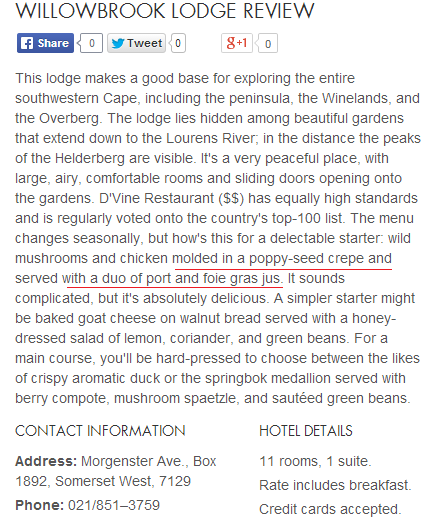
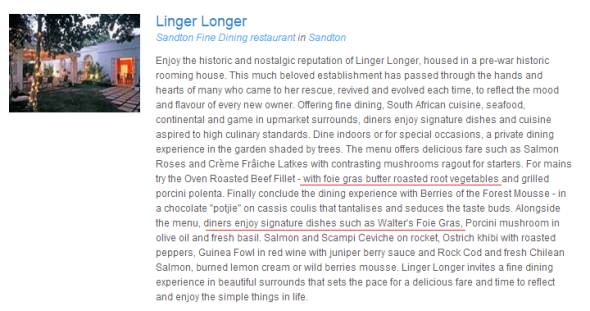
Most foie gras producers do not consider their methods cruel, insisting that it is a natural process exploiting the animals’ natural features. Producers argue that wild ducks and geese naturally ingest large amounts of whole food and gain weight before migration. This is far from actual truthful though as like humans their stomach will inform their brain via neurological signals that their tummy is now full thus ceasing eating. The same neurological behaviour is also seen within geese and ducks to many more animals too. Despite the scientific evidence, they claim that geese and ducks do not have a gag reflex in their throats the same way that humans do, and therefore do not appear to find force feeding uncomfortable. Michael Ginor, owner of Hudson Valley Foie Gras, author of Foie Gras… A Passion, claims his birds come to him to be fed and says this is important because “a stressed or hurt bird won’t eat and digest well or produce a foie gras.”
According to Industry groups including the CIFOG, and researchers at INRA, forced feeding is not a cruel procedure. Mirepoix USA, a top provider of goose and duck foie gras, alleges that the animal rights activists attack is a form of prohibition against a cuisine item. Mirepoix claims that the use of the term “diseased” to refer to fatted liver is inaccurate and that geese and ducks naturally store dead fish in their esophagi for long periods of time.[28] The ducks used in foie gras production, however, are a hybrid of Pekin (a type of Mallard) and Muscovy ducks, both of which are dabbling ducks and as such, subsist mainly on a diet of underwater vegetation, larvae, and various insects.
Chefs and diners alike have been force-fed misinformation about how its production affects the welfare of the birds, but here are the scientific facts:
Confinement: The birds are kept in barren pens or cages that restrict their freedom of movement, cause painful injuries to their feet, and prevent them from enjoying any natural behaviour.
Stress and Pain: Insertion of the feeding pipe stresses the birds, as it overcomes their gag reflex and can cause painful injuries to the throat.
Death: During the force-feeding phase, mortality rates are three to 10 times as high as in flocks of non-force fed ducks of the same age. These high rates are due to the injuries to the throat, liver failure, and heat stress – all of which are directly linked to the force-feeding practice.
Conclusion
Trading and producing foie gras within south Africa must stop sooner rather than later. The cruelty involved to produce such a rich yet stagnant dish of inhumane cruelty is beyond comprehensible of which we are shocked to see such a copious demand for foie gras products increase despite awareness and activism within south Africa. An all out ban within Europe, South America and the United States via banning exports, productions and “avine bird parts” used in the process of foie gras production will not necessarily stop demand or production within south Africa. The craze for foie gras in south Africa is great of which banning exports will begin a more “increased” trade of foie gras within south Africa. The entire trade has to stop now.
Take action today - educate yourself and others on the certified cruelty of foie gras cruelty here
Take action and sign the petitions below today;
https://www.change.org/petitions/amazon-stop-torturing-ducks-for-foie-gras
http://www.petitionspot.com/petitions/foiegras
http://www.change.org/petitions/irish-restaurants-stop-serving-cruel-foie-gras
View more petitions here;
http://www.change.org/en-GB/search?utf8=%E2%9C%93&q=foie+gras
http://www.care2.com/find/site#r=petitions&q=foie+gras+
Please make a small donation to International Animal Rescue Foundation South Africa your donation goes directly to our Pan African Projects working to Fund African Wildlife Survival. Food, medications, anti-poaching-equipment, and much more is what your donations go into. For further information please email us below/
http://www.international-animalrescue-foundation.org.uk/general-enquiries/
Thank you for reading;
Chief Environmental Registrar.

